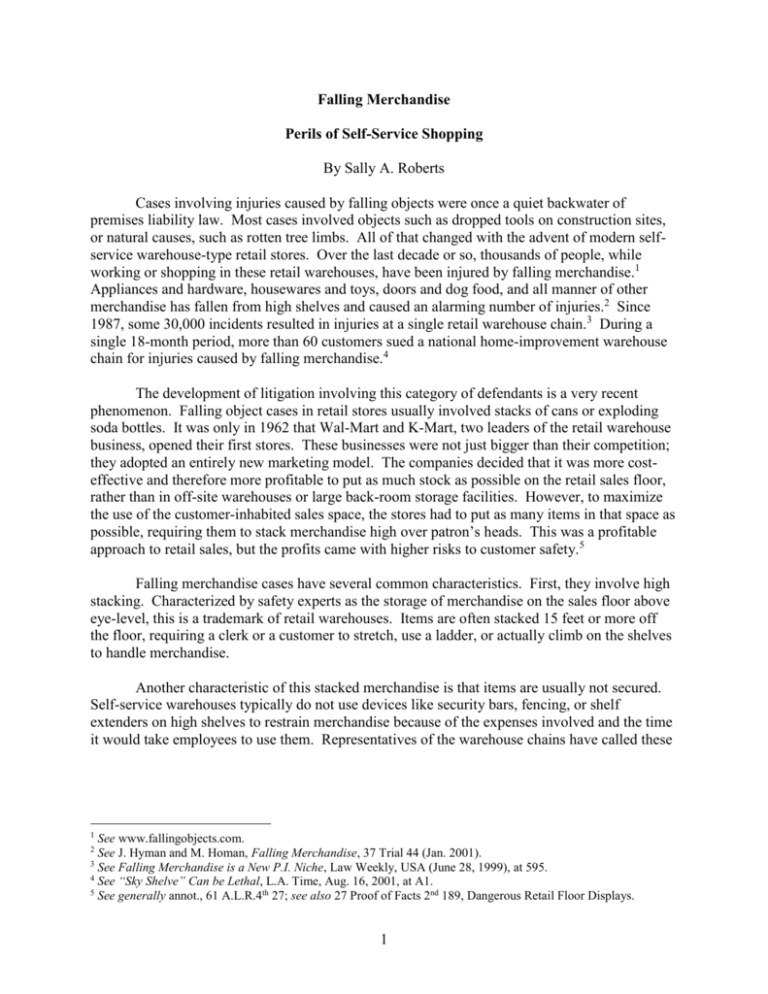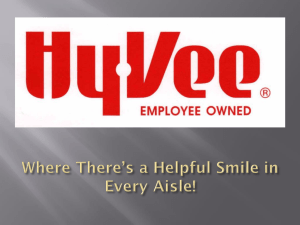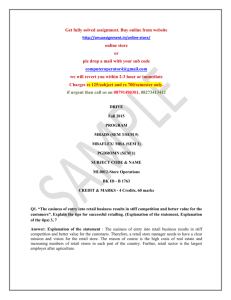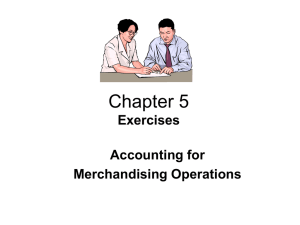Falling Merchandise - Sally A. Roberts Law Firm
advertisement

Falling Merchandise Perils of Self-Service Shopping By Sally A. Roberts Cases involving injuries caused by falling objects were once a quiet backwater of premises liability law. Most cases involved objects such as dropped tools on construction sites, or natural causes, such as rotten tree limbs. All of that changed with the advent of modern selfservice warehouse-type retail stores. Over the last decade or so, thousands of people, while working or shopping in these retail warehouses, have been injured by falling merchandise.1 Appliances and hardware, housewares and toys, doors and dog food, and all manner of other merchandise has fallen from high shelves and caused an alarming number of injuries.2 Since 1987, some 30,000 incidents resulted in injuries at a single retail warehouse chain.3 During a single 18-month period, more than 60 customers sued a national home-improvement warehouse chain for injuries caused by falling merchandise.4 The development of litigation involving this category of defendants is a very recent phenomenon. Falling object cases in retail stores usually involved stacks of cans or exploding soda bottles. It was only in 1962 that Wal-Mart and K-Mart, two leaders of the retail warehouse business, opened their first stores. These businesses were not just bigger than their competition; they adopted an entirely new marketing model. The companies decided that it was more costeffective and therefore more profitable to put as much stock as possible on the retail sales floor, rather than in off-site warehouses or large back-room storage facilities. However, to maximize the use of the customer-inhabited sales space, the stores had to put as many items in that space as possible, requiring them to stack merchandise high over patron’s heads. This was a profitable approach to retail sales, but the profits came with higher risks to customer safety.5 Falling merchandise cases have several common characteristics. First, they involve high stacking. Characterized by safety experts as the storage of merchandise on the sales floor above eye-level, this is a trademark of retail warehouses. Items are often stacked 15 feet or more off the floor, requiring a clerk or a customer to stretch, use a ladder, or actually climb on the shelves to handle merchandise. Another characteristic of this stacked merchandise is that items are usually not secured. Self-service warehouses typically do not use devices like security bars, fencing, or shelf extenders on high shelves to restrain merchandise because of the expenses involved and the time it would take employees to use them. Representatives of the warehouse chains have called these 1 See www.fallingobjects.com. See J. Hyman and M. Homan, Falling Merchandise, 37 Trial 44 (Jan. 2001). 3 See Falling Merchandise is a New P.I. Niche, Law Weekly, USA (June 28, 1999), at 595. 4 See “Sky Shelve” Can be Lethal, L.A. Time, Aug. 16, 2001, at A1. 5 See generally annot., 61 A.L.R.4th 27; see also 27 Proof of Facts 2nd 189, Dangerous Retail Floor Displays. 2 1 safety devices impractical, and have stated that merchandise can be safely stacked on high shelves without using physical restraints.6 A third similarity of stacked merchandise cases is the event that triggers the accident. These cases generally involve moving merchandise that has been stacked unstably, moving items on one shelf in such a way that items on an adjacent shelf fall, placing boxes of different sizes on top of each other, and stacking heavy items on top of lighter ones. Items that hang over the edge of a shelf are also problems, as is merchandise too large for the shelf on which it is places. A fourth common characteristic of these cases is the store’s failure to provide customers with any warning of potential danger. It is probably fair to say that merchants are indeed aware of the risk that merchandise stacked on a high shelf may fall and injure a customer. Nevertheless, they do not warn patrons of these risks with signs or banners and do not cordon off aisles when merchandise is being stocked. The fifth common feature of falling merchandise cases is the lack of employee training. Store personnel are often inadequately trained, if they are trained at all, in proper stocking techniques or the recognition and correction of the potential hazards of falling objects. Finally, falling merchandise cases often involve similar injuries. A significant percentage of the injuries caused by high stacked merchandise occur to the head, neck, back, and upper torso. Even light merchandise becomes dangerous as it falls because the acceleration of objects caused by gravity means that a five-pound object falling two feet creates a force at impact of some 319 pounds. Notice The general rule in premises liability cases is that a plaintiff must prove notice of a defect. One way to avoid proof of notice is to allege and prove that the property owner or its agent or employee acted in an affirmative manner so as to either create the defect or create a method of operation that is inherently dangerous by design. In a method of operation case, the business property owner chooses a method of operation, such as stacking merchandise in a particular manner. If a plaintiff is injured by a foreseeable defect due the method of operation, the plaintiff need not prove notice of the defect. The defendant’s negligent method of operation is an affirmative act of the defendant that obviates the need to prove actual or constructive notice. In Holody v. First National Supermarkets, 18 Conn. App. 533 (1989), the plaintiff was not required to prove notice where the defendant had set up juice bottles in a dangerous position that proximately caused the plaintiff’s injuries. It is important to note that the method of operation must create a danger in a foreseeable manner. 6 See, e.g., Meek v. Wal-Mart Stores, Inc., 72 Conn. App. 467 (2002). A Wal-Mart store manager testified that although it would have been feasible to use a restraining bar in a shelf display, “it wouldn’t make it very customer friendly,” and “it could pose problems for making it shopable.” 2 The method of operation was applied by the court in Meek v. Wal-Mart, 72 Conn. App. 467 (2002), a leading Connecticut falling merchandise case. In Meek, the plaintiff shopper, while examining some merchandise in the defendant’s self-service department store, was struck in the back and neck by two large folding camp table boxes that fell from an overhead shelf. The oversized boxes had been stacked vertically by defendant’s employees on an overhead shelf (to provide better visibility of merchandise) and only kept in place by a small plastic fence approximately one-tenth the height of the merchandise. The method of operation was applied by the court in Meek, in holding that where the plaintiff alleged a specific, affirmative act of negligence by the defendant (i.e., improperly stacking the camp tables in a less-stable, vertical position), proof that the defendant had notice of the dangerous condition was unnecessary. The defendants argued that the plaintiff must have been negligent because, however poorly stacked, and regardless of how they got that way, the boxes would not have toppled over onto the plaintiff without some intervening cause that set them in motion because objects at rest tend to stay at rest. The court noted, however, that other courts have rejected this inertia argument: “The laws of physics do not resolve the question of legal cause.” Id. at 489. Further, a plaintiff in a personal injury action is presumed to have exercised due care, and it is the burden of a defendant, who asserts the doctrine of comparative negligence, to prove otherwise. The court commented that storekeepers who balance merchandise on display in a precarious manner “should anticipate that slight force, not sufficient ordinarily to suggest to the actor who does not know of the peril that injury will result, may be sufficient to cause injury, and the storekeeper is not relieved of the consequences of this negligence by an intervening act which he should have anticipated.” Id. at 477. The court in Meek further acknowledged that this “notion frequently has been applied in cases involving slip and fall accidents in self-service establishments that were caused by the foreseeable behavior of other customers dropping or spilling merchandise on the floor.” Id., fn 6. In Meek the court stated that “there is no logical distinction, however, between a situation in which the storeowner directly creates the condition or defect, and where the store owner’s method of operation creates a situation where it is reasonably foreseeable that the expectable acts of third parties will create a dangerous condition or defect.” Id at 478. 3




